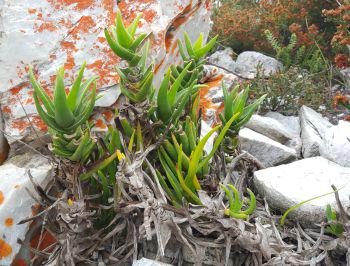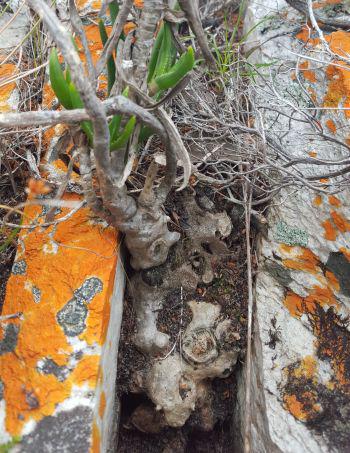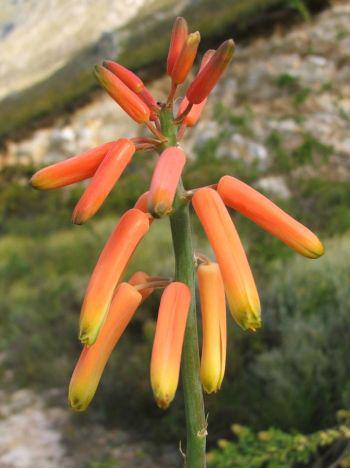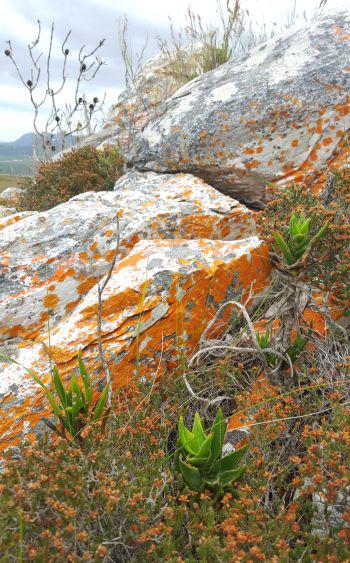Aloiampelos juddii
Aloiampelos juddii Van Jaarsv.
Family: Asphodelaceae
Common names: Koudeberg aloe (Eng.); Baardskeerdersbosvuurpylaalwyn, (Afr.)
Introduction
Aloiampelos juddii is a welcome addition to the Cape flora and in particular the assemblage of Fynbos aloes that are found in the mountainous and coastal habitats of the Cape. The species is closely related to Aloiampelos commixta from which it may be distinguished by its more slender, densely leafy branches, smaller leaves and taller inflorescences.

Description
Description
Aloiampelos juddii is a low-growing, succulent plant with solitary or branching stems that are erect, becoming sprawling with age. Stems may reach a height of 600 mm long and 10 mm thick. A single clump may reach a diameter of approximately 800 mm. In older specimens the stem bases give rise to an underground succulent to near-woody caudex, from which young stems readily arise. The stems have an ash-like, grey to white appearance, that is strikingly similar in colour to the Table Mountain Sandstone rock type on which the plants grow. The stem colour contrasts well with the bright to dark green leaves, which are triangular-ovate to triangular-lanceolate, 55–75 × 15–25 mm. The leaves have conspicuous red tips and have firm, white teeth, up to 1 mm long, along its margins. Leaves are typically carried towards the stem apices, leaving the lower half of the stems bare. The leaves are faintly striate, meaning they possess lightly visible longitudinal lines on their surfaces.

The inflorescence is more or less cylindrical, unbranched and about 300 mm long. The loosely flowered racemes are about 50–80 mm long. The pencil-shaped flowers are large, loosely spaced and spreading away from the inflorescence stalk, when they are in bud. When the flowers open, they tend to take on a more hanging habit. The flowers are bright reddish orange with yellowish green tips. Flowering takes place in early spring (August and September) in cultivation but in the wild it flowers more toward late spring and early summer (late October and November).

Conservation Status
Status
Aloiampelos juddii is a recently described species which has a small, restricted distribution. According to the Red List of South African plants, this species is considered Endangered (EN) because of its highly localized range and large parts of its habitat are invaded by unmanaged alien invasive plants that are displacing indigenous species and damaging the habitat. It is currently known from one location but it is likely that several more populations might be found in its habitat range, but this is yet to be ascertained.

Distribution and habitat
Distribution description
Aloiampelos juddii is restricted to the Overberg coastal mountains in the Western Cape, between Gansbaai and Baardskeerdersbos, and occurs at an altitude of 300-500 m , where it favours southeast-facing, rocky, sandstone outcrops and ridges, which provides a degree of shelter against wind and fire. It occurs in mineral-poor, coarse, white sands derived from the Nardouw subgroup of Table Mountain Sandstone.
Derivation of name and historical aspects
History
The genus name Aloe is derived from the Arabic, Alloch, and translated as Allal in Greek and Hebrew, literally meaning ‘bitter’ or ‘bitter sap’, which is descriptive of aloe sap.
The genus name has recently been changed from Aloe to Aloiampelos for all rambling aloes which include Aloe ciliaris (now Aloiampelos ciliaris), A. commixta (now Aloiampelos commixta), A. decumbens (now Aloiampelos decumbens), A. gracilis (now Aloiampelos gracilis), A. striatula (now Aloiampelos striatula) and A. tenuior (now Aloiampelos tenuior). This change was brought about because of new findings from molecular studies, that suggest that not all species of Aloe have the same evolutionary origin and are, therefore, less closely related than previously thought. Based on this, Aloe now comprises of several subgenera namely Gonialoe (angle-leaf aloes), Aristaloe (needle-leaf aloes), Aloe (true aloes), Aloiampelos (rambling aloes), Kumara (fan-leaf aloes) and Aloidendron (tree aloes).
Aloiampelos juddii was named for Mr Eric Judd, a Cape-based photographer, naturalist and botanical artist, who has a deep interest in aloes and who in the late 1960s authored the field guide, What aloe is that? His famous paintings are highly sought after and adorn many private and corporate art collections.

Ecology
Ecology
The shape and arrangement of the bright red to orange flowers, leans itself to attracting birds, in particular nectar feeders such as sunbirds, which most likely pollinate the flowers. Nectar birds such as sun- and sugar birds are typically associated with aloes and Fynbos vegetation in the Cape. Since Aloiampelos juddii occurs in a fire-prone vegetation, plants are adapted to fire by means of their near-woody bases from which it can resprout after fires. As an additional recruitment strategy, seeds germinate and grow into mature plants much more readily in the protection of southeast-facing ridges and rocky outcrops, which also provides an insurance of water accumulation during winter and moisture sustenance during the hot summer months. Where the wind disperses the winged seeds further away from their rocky sheltered mother plants, the thicker vegetation in which they land, provides a nursing situation in which seedlings have better chance of reaching maturity.
Uses
Use
There are no medicinal uses recorded for Aloiampelos juddii. As a garden plant, Aloiampelos juddii is very useful for its toughness and tolerance to minimal watering, as well as for attracting birds to the garden.

Growing Aloiampelos juddii
Grow
Aloiampelos juddii grows well in cultivation in Mediterranean climates. It produces rewarding displays of warm colour in early summer. Plants tend to become stubby when old, and would benefit from being cut back to produce fresh growth.
Seeds must be harvested in late summer and should be sown fresh into seed trays at the onset of the following autumn and winter season. A depth of about 2 or 3 times the size of the actual seed, is ideal. Water the trays using a fine mist sprayer, to ensure the seeds are not sprayed out of the container. Care must be taken to avoid over watering and too much shade, as these lead to ideal conditions for fungal and viral infections, as well as root rot. It is advisable to spray a pre-emergence fungicide as a precaution to the development of fungal diseases, such as damping off. Once germinated, leave the seedlings in the trays and reduce watering to no more than once a week. Plantlets can be transplanted when they reach approximately 40–50 mm high. Use a well-drained medium consisting of equal parts of fine and clean compost, river sand and loamy soil. Once established, plants grow relatively fast, provided good after care is given, with ample light and a disease-free environment.
Cuttings also root easily and can be made in winter.
References
- Carter, S., Lavranos, J.J., Newton, L.E. &Walker, C.C. 2011.Aloes The Definitive Guide. Royal Botanic Gardens Kew, Richmond.
- Van Wyk, B. & Smith, G.F. 2014. Guide to the aloes of South Africa. Briza Publications, Pretoria.
Credits
Werner Voigt
Karoo Desert National Botanical Garden
November 2016
Plant Attributes:
Plant Type: Succulent
SA Distribution: Western Cape
Soil type: Sandy, Loam
Flowering season: Early Summer, Late Summer
PH: Acid
Flower colour: Green, Red, Yellow, Orange
Aspect: Full Sun
Gardening skill: Easy
Special Features:
Horticultural zones








Rate this article
Article well written and informative
Rate this plant
Is this an interesting plant?
Login to add your Comment
Back to topNot registered yet? Click here to register.